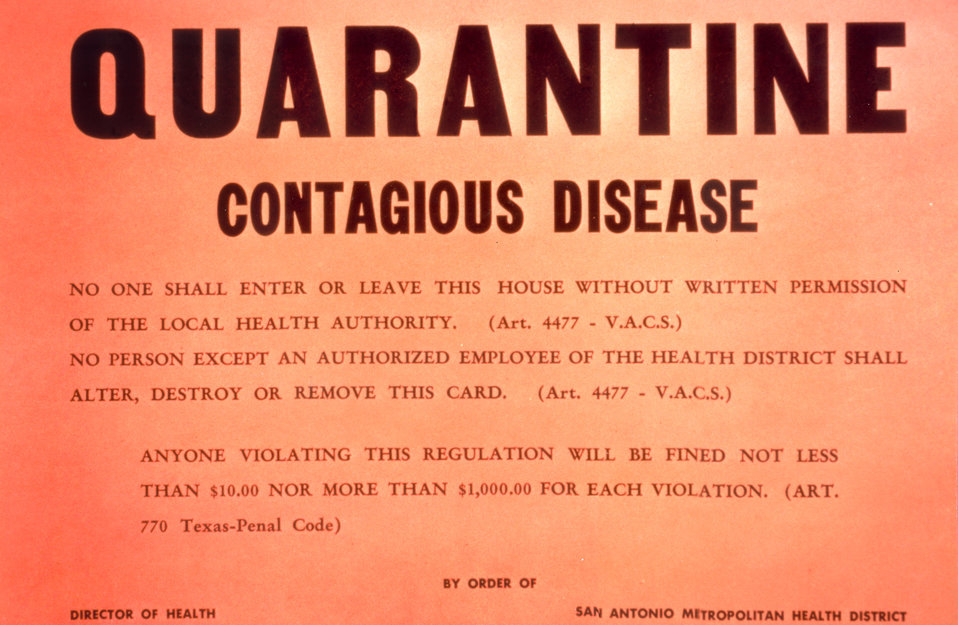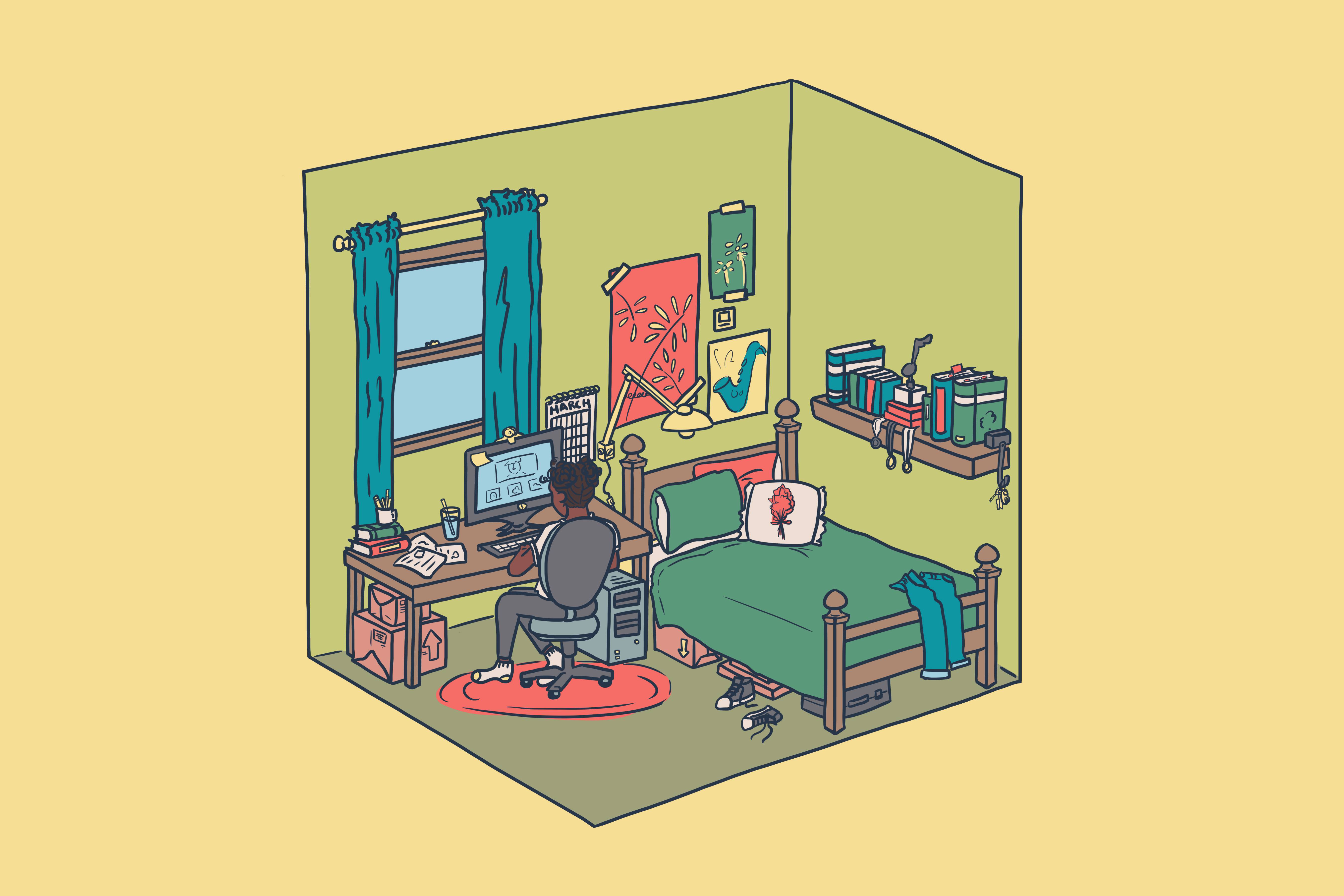Published by Emily Baughman

“This historic image depicts a quarantine card, which would be used to notify people not to enter or leave a house that had been quarantined due to the presence of a contagious disease. This warning was under the auspices of the Director of Health, of the San Antonio Metropolitan Health District.” Image courtesy of the CDC, https://phil.cdc.gov/Details.aspx?pid=1327.
From curses to coughs, humanity has been using quarantines for thousands of years. While it hasn’t always been a straight forward line, our methods of isolation have been continuously shifting along with our understanding of how disease spreads. Overall, as we’ve better understood the spread of disease, we’ve been better able to prevent it.
Before the age of medicine, disease was thought to be a curse on those who had wronged a higher power. Being sick was a punishment. Cautionary moral tales tell stories of people and communities cursed by horrific disease (Tyson 2004). Don’t want to get sick? Be a good person. In biblical texts, those “cursed” to suffer from leprosy became outcasts of society and were seen as “unclean” (Tyson 2004). For a long period of time, mankind lacked a proper understanding of disease because the human eye can’t see the tiny things that get us sick. People only understood what they saw about disease. Visual cues of illness like skin disfigurements linked to leprosy and bloody coughs linked to mysterious plagues were how people knew someone was sick, but they didn’t know how someone got these horrible infections. Facing something unknown breeds fear and for those who already feared the supernatural, connecting it to an unseeable force of disease helped rationalize isolating the sick.
Moving forward in history to Ancient Greece, ideas shifted away from societal forced isolation and toward new ideas of organized quarantines. The English word “quarantine” derives from the Latin word for “forty” because original quarantines lasted 40 days (Tyson 2004). The significance of 40 days is unknown; however, some academics point towards Abrahamic religions, where segments of 40 days are seen throughout holy texts (Tognotti 2013). Others suggest the use of 40 days comes from the mind of Hippocrates (Tognotti 2013). Hippocrates created the idea of miasma theory, which explained that disease was not supernatural but instead caused by “bad air” or foul smells (Karamanou 2012). In this theory, it took 40 days for miasma to be moved out of someone’s body and for the disease to be completely gone (Tognotti 2013). Miasma theory established the idea that disease was something natural and spreadable because it couldn’t pop out of thin air due to a curse. While miasma theory is debunked today, these ideas from Ancient Greece helped move humanity towards the understanding that disease can be spread, which created a new era of medicine. However, medical history rarely develops in a straight line, and humanity took a step back before moving forward.

During the Black Plague, having the doctor come visit often meant death was close behind. People did everything they could to keep from getting sick including boarding up their windows and blocking the doors. Artwork courtesy of the author.
From plague outbreaks to cholera epidemics, diseases in the Middle Ages spread quickly through communities and decimated populations. In this fearful time, many fell back to ideas of curses. People knew disease spread but didn’t know how, and that fear of the unknown developed into fear of the “other”. During times of outbreak, towns would shut their gates and surround their walls with the military to prevent anyone from entering their city (Gensini 2004). Many cities used already held prejudices against certain groups to outright blame them for bringing disease and refuse them entry to the city, while claiming they only wanted to protect their citizens from illness (Gensini 2004). During the Black Death, people who were already social outcasts, such as “witches” and Jewish people, were blamed for the disease (Lucas 2018). Witches were burned in order to stop their curses. Many Jewish people were tortured until they confessed to causing disease and then were also burned (Lucas 2018). Fear is a powerful human emotion and it’s often easier to blame something tangible over something unseen. After such a long dark period in history, humanity luckily shifted back towards ideas of the natural spread of disease.
Travelling forward to the 14th century, trade on the Mediterranean Sea increased rapidly and keeping disease at bay became increasingly more important (Tognotti 2013). Humanity was becoming more interconnected and this led to medical advancements out of necessity. Unlike centuries before, completely closing trade during a plague outbreak was not an option, as cities surrounding the Mediterranean were heavily reliant on each other economically. The idea of miasma theory had made a glorious return but now included new ideas on person-to-person spread. Off the coast of Italy a plague hospital was built, stretching wide along an island shore, both welcoming trade ships and helping control the spread of disease. Many lazarettos, or plague hospitals, got their name from the biblical Lazarus who rose from the dead, invoking the idea that those who fell ill within their walls would also rise again (Tognotti 2013). Humanity had more hope of recovery than previous generations, for whom a diagnosis came with a death sentence. At the port, all of those aboard ships were checked for disease. Both the ill and seemly healthy were quarantined in the lazaretto for 40 days before being allowed into the city (Tognotti 2013). While lazarettos may not have completely halted the spread of disease, they likely increased survival rates by slowing transmission and increasing the resources available to the ill (Tognotti 2013). As an unforeseen benefit, the large number of cases that came through these lazarettos helped give medical workers clearer ideas how disease spread.

Lazarettos were often the first thing sailors saw when approaching a city. Many were built on islands far from the city to better reduce the spread of disease. Artwork courtesy of the author.
In 2020, our global connection has made the spread of everything easier, from media and ideas to disease. While the quick spread of disease is scary, our interconnection proves that the spread of knowledge makes humanity stronger. Combined efforts across different countries have pushed research and global understanding forward. Knowledge is power and it isn’t only benefiting the medical community. Artists and business owners from independent fashion designers to lawn furniture makers are being informed and are able to help by making masks for medical workers who are in desperate need. Being fearful of the unknown is valid and natural; however, as we’ve seen in history, hunting for a scapegoat to blame doesn’t help resolve these fears or the underlying problems. As the centuries have rolled on, humanity has stood strong because of our developing understanding of medicine and our ability to rely on one another. As we move cautiously forward, looking at the past gives comfort that sticking together, at least 6 feet apart, is the best thing we can do.

“Sticking together while remaining six feet apart.” Artwork courtesy of the author.
Works Cited:
Gensini, G. “The Concept of Quarantine in History: from Plague to SARS.” Journal of Infection, vol. 49, no. 4, 2004, pp. 257–261., doi:10.1016/j.jinf.2004.03.002.
Karamanou, Marianna, et al. “From Miasmas to Germs: A Historical Approach to Theories of Infectious Disease Transmission.” Le Infezioni in Medicina , 20 Mar. 2012, pp. 58–62.
Lucas, Shaina. “The Unfortunate Scapegoats of the Black Death Were Mainly Heretics, Jews and Witches.” HistoryCollection.co, 4 Nov. 2018, historycollection.co/the-unfortunate-scapegoats-of-the-black-death-were-mainly-heretics-jews-and-witches/.
Tognotti, Eugenia Tognotti. “Lessons from the History of Quarantine, from Plague to Influenza A – Volume 19, Number 2-February 2013 – Emerging Infectious Diseases Journal – CDC.” Centers for Disease Control and Prevention, Centers for Disease Control and Prevention, Feb. 2013, wwwnc.cdc.gov/eid/article/19/2/12-0312_article.
Tyson, Peter. “A Short History of Quarantine.” PBS, Public Broadcasting Service, 12 Oct. 2004, www.pbs.org/wgbh/nova/article/short-history-of-quarantine/.
Emily Baughman is the current Spring 2020 Education Intern at the International Museum of Surgical Science. She is in her senior year finishing a biology major at Elmhurst College. She enjoys creating artwork inspired by her love of science and medicine.


